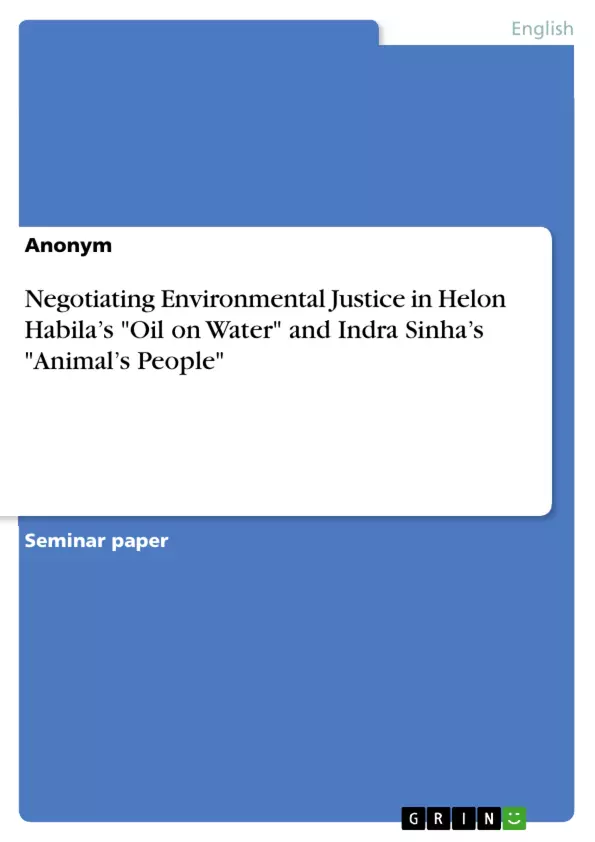This paper analyzes how aspects of environmental injustices are staged and negotiated in the plots of both contemporary novels "Animal's People" by Indra Sinha and "Oil on water" by Helon Habila. Here, paticular focus is placed on the parallels between the two novels as well as on the divide between the Global South and the Global North.
The subsequent chapter outlines the theoretical framework of environmental justice by portraying its emergence, its four different aspects and its application to the division between the Global South and the North. The third chapter applies each aspect of environmental justice to the plot of the two novels. Here, the aspect of social injustice refers primarily to the social consequences of corporate and government activities. Lastly, chapter four summarizes the results and draws conclusions.
Inhaltsverzeichnis (Table of Contents)
- Introduction
- Conceptualizing environmental justice.
- The emergence of the movement...
- Aspects of environmental justice
- Environmental justice and the Global South.........
- Environmental injustices in Helon Habila's Oil on Water and Indra Shina's Animal's People.
- Distributive injustices
- Procedural injustices.
- Corrective injustices
- Social injustices .......
- Conclusion...........
- Bibliography
- Primary Sources.
- Secondary Sources........
Zielsetzung und Themenschwerpunkte (Objectives and Key Themes)
This paper analyzes the environmental injustices portrayed in the novels Animal's People by Indra Sinha and Oil on Water by Helon Habila, focusing on the parallels between them and the divide between the Global South and the Global North. The study explores the theoretical framework of environmental justice, encompassing its emergence, various aspects, and its application to the relationship between the Global South and the North. It further examines how these aspects of environmental injustices are staged and negotiated in the narratives of both novels.
- The emergence and evolution of the environmental justice movement
- The different aspects of environmental justice: distributive, procedural, corrective, and social injustice
- The connection between environmental justice and the Global South
- The representation of environmental injustices in the novels Animal's People and Oil on Water
- The parallels and differences in the portrayal of environmental injustices in both novels
Zusammenfassung der Kapitel (Chapter Summaries)
The first chapter introduces the concept of environmental justice through a quote from Vandana Shiva, emphasizing the correlation between economic growth and environmental damage. It then explores the environmental justice movement and its origins in the 1982 protests in Warren County, North Carolina, highlighting the connections between racism, toxic waste disposal, and environmental hazards. This chapter establishes the theoretical framework for the study by examining the evolving scope of environmental justice research and the various definitions that have emerged. The second chapter delves into the theoretical framework of environmental justice by outlining its historical development and its four key aspects: distributive justice, procedural justice, corrective justice, and social justice. It analyzes how these aspects relate to environmental injustices in the context of the Global South and the Global North.
Schlüsselwörter (Keywords)
The key concepts and topics explored in this paper include environmental justice, environmental racism, environmental equity, distributive justice, procedural justice, corrective justice, social injustice, Global South, Global North, environmental degradation, exploitation, political instability, civil commotion, Animal's People, Oil on Water, Indra Sinha, Helon Habila.
- Quote paper
- Anonym (Author), 2021, Negotiating Environmental Justice in Helon Habila’s "Oil on Water" and Indra Sinha’s "Animal’s People", Munich, GRIN Verlag, https://www.hausarbeiten.de/document/1351665


